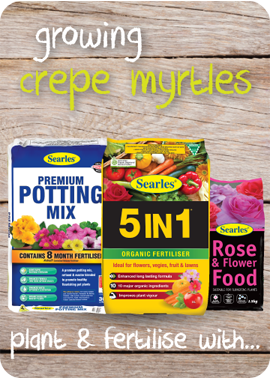Growing crepe myrtles
 |
|
The crepe myrtle (Lagerstroemia indica) is another Searles favourite in the flowering tree family! Crepe myrtles are deciduous, flowering profusely with compact crepe-like blooms throughout the hot summer months, then losing their leaves in late Autumn to show off, another draw card, its textured bark. In warmer areas flowering can start from late spring and finish in Autumn. Flower colours available range from white to pink, purple and mauves. This small tree grows well in most Australian gardens and its ability to be reshaped into various garden applications make them a popular option for many Australian gardens.
Varieties of crepe myrtles 'Indian Summer' Crepe myrtle (Lagerstroemia indica x L. fauriei) These newly bred forms are more resistant to diseases like powdery mildew and have larger flowering heads. Available in a variety of colours and sizes ranging 3m to 6m once mature.
'Diamonds in the dark' Series Relatively new on the market, this revolutionary new range features compact dark foliage set against vivid summer crepe-like blooms. The 'Diamonds in the Dark' range grow to 3m x 2.5m making them suitable for smaller gardens, hedging and planted in larger pots for balcony/patio displays. 'Diamonds in the Dark' follow the same traits as other crepe myrtles, they are deciduous, losing their leaves in autumn and burst into their unique dark foliage hallmark early spring followed by blooms for summer. more info
Growing and planting crepe myrtles This small tree grows well in most Australian gardens. The Indian Summer series tolerate the cold climates well. If possible in cold mountain areas plant in the warmest part of the garden. Crepe myrtles grow best in a full sun position. Dig 5 IN 1 Organic Fertiliser into existing soil before planting crepe myrtles into the ground. For large pots, fill with Premium Potting Mix. Fertilise early spring with a controlled release fertiliser, Searles Rose & Flower Plant Food. Additional applications of Searles Flourish Soluble Plant Fertiliser during flowering season will promote better flowering. Water regularly until established.
Pruning crepe myrtles You can prune your crepe myrtle to keep it compact but many gardeners leave them alone, as their natural branch formation is highly desired. Prune spent flower heads in autumn after flowering has finished to encourage bettter flowering next season. Look out for more compact varieties if you have a smaller garden space. Crepe myrtles are able to be trained in many ways, from the standard leave alone tree to miniature and low growing spreading plants. Some varieties do tend to sucker at the base of the plant, promptly cut these suckers off to concentrate new growth and better flowering in the higher branches.
Pests & diseases of crepe myrtles Powdery mildew is its biggest enemy. Look for more fungal resilient varieties on the market, such as the Indian Summer series. If outbreaks are severe, control with Searles Wettable Sulphur.
|
--------------------------------- |





